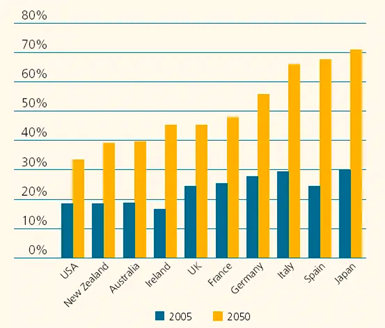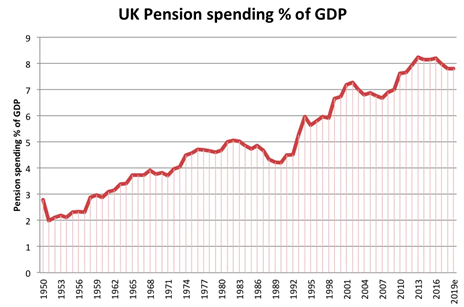1. Introduction
Ageing refers to “a dynamic process in which the proportion of young people in the total population decreases, and the proportion of the elderly increases gradually due to the decrease in the young population and the increase in the elderly population.” It is widely agreed that if “10% of a country or region's population is over 60 years old, or over 7% of its population is over 65, the country or region has entered an ageing society.” By 2013, China's elderly population (aged 65 and above) accounted for 9.68% of the total population, far beyond the threshold.
Population ageing occurs worldwide rather than simply affecting a single country. It is a product that emerges when the economy and society develop to a certain extent.
The public and experts are becoming increasingly aware of the rapid change in China's population structure, transitioning from a younger population to an ageing one. This change can be disastrous, as China relies heavily on its primary industry, which has benefited from China's demographic dividend. Hence, slowing down the ageing process has become a priority and a critical issue waiting to be addressed.
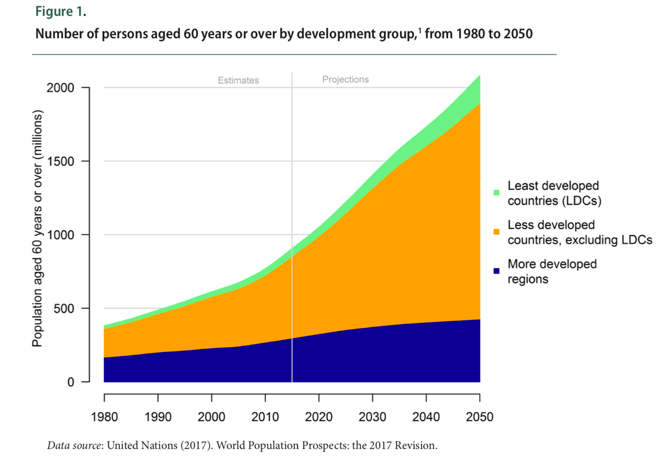
Figure 1. Number of persons aged 60 years or over by development group from 1980 to 2050, source: United Nations (2017). World Population Prospects: the 2017 Revision.
2. Population ageing in China
2.1 The Features and Current Situation of the Ageing Process in China
There’re some notable characteristics of ageing process in China, which are: a large population base of elderly people, a rapid rate of ageing, and large differences between different regions.
Here are some authoritative data and statistics related to the current of the ageing process of the population in China and using the data to make comparisons to see how quick and how much it has changed in recent years.
According to data from the 6th demographic census completed by the National Bureau of Statistics of China, there were 132,752,961 "younger elderly" (aged from 60 to 74, according to the World Health Organization’s division of elderly in 2010. In addition, 42,857,259 people are known as "elderly" (aged from 75 to 89, according to the World Health Organization’s division of elderly), and 1,983,220 people were aged 90 or above. The percentage of elderly aged 60 and above was approximately 13.32%, with a population of 177,593,440. Furthermore, those aged 65 and above numbered 118,926,158, constituting about 8.92% of the total population [1].
However, the 7th demographic census completed in 2020 showed that the population aged 60 and above was 264,018,766, occupying about 18.70% of the total population. Additionally, people aged 65 and above made up 13.50% of the total population, with a population of 190,635,280 [1].
Notably, the percentage of elderly in the total population increased by 5.38% during the 10 years, and the percentage of elderly aged 65 and above increased by 4.58%. Also, it is interesting to note that the difference between the total percentage of elderly and the percentage of elderly who are 65 and above increased from 4.4% to 5.2% [1].
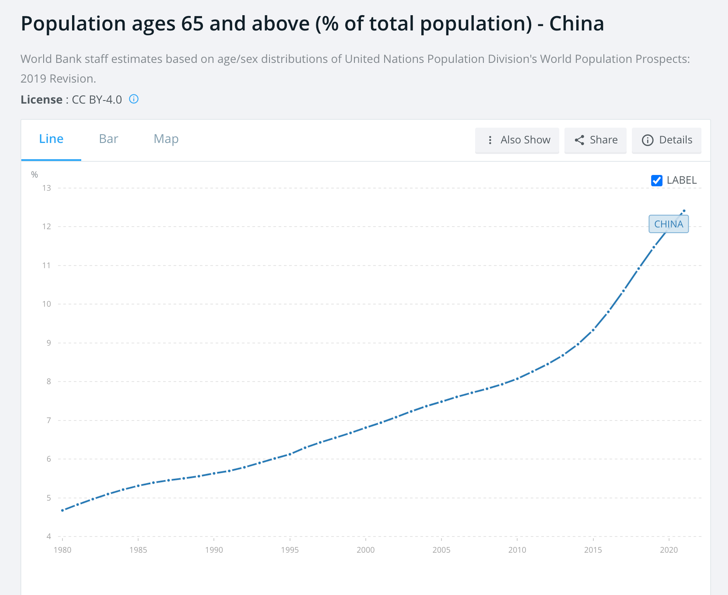
Figure 2 Changes in the proportion of the population over 65 in China (source: https://data.worldbank.org/indicator/SP.POP.65UP.TO.ZS?end=2021&locations=CN&start=1980)
In China, there does not only exist rapid growth in the dependency ratio, but the proportion of the oldest old population in the population is also rising quickly. The size of China's elderly population over the age of 65 will further surge, reaching 240 million in 2030 and 365 million in 2050; growth in the ageing population is expected to slow down and stagnate at a high level after peaking around 2055 to 2060. That is, when India becomes the most populous country in the world in the next few years, China will still have the largest population of elderly people. For a long time, the elderly population’s proportion in the population will remain at a high level of around 30% [2].
For the proportion of the elderly population to increase from 7% to 21% in Europe and North America, it usually takes around 80-100 years, and it takes about 35-40 years in Japan, Thailand, China, and Korea [3]. Rapid rate of population ageing makes the tackling of the issues more challenging.
It also needs to be concerned that even with the easing of the policy controls over birth, there is no strong evidence fertility rates are expected to grow significantly. Moreover, compared to other countries that are also facing population ageing. China is also suffering from the issue of ‘getting old before becoming rich’ [2].
The significant difference in the extent of population ageing is due to the unbalanced development between China's eastern and western regions. Thus, researchers from different countries have conducted many pieces of research worldwide [4].
Shrestha studied the ageing process of developing countries, including China, and significant differences in the levels of ageing between states are shown. In addition, the speed of population ageing is much faster in developing countries than in industrialized countries [5].
In China, researchers are using different methods to evaluate the ageing levels of the population in various regions.
Quantitative measurement methods have been used by Wu Zhengzheng, Yuan Jun, and Wu Dianting to measure the ageing level of rural areas in China. They found that almost all areas in the eastern coastal region of China had entered an ageing state. In contrast, the ageing process speeds up gradually in the central and western areas after the "Eleventh Five-Year Plan." [6].
Li Xiuli and her partners analyzed the extent of the ageing process in different regions of China using a variance. As a result, they concluded that the faster the economic growth, the higher the level of ageing in the region [7].
Wang Zhibao studied the process of population ageing and believed that population ageing in China highly depends on the extent of economic development. Hence, the population ageing in a region significantly has a positive correlation with that area's economic development level [7].
Peng Xizhe, however, offers another viewpoint on this. He acknowledges that there are significant disparities in the socioeconomic growth and demographic shifts occurring in various parts of China. While western Chinese provinces like Qinghai have not yet reached the stage of an ageing society, Shanghai did so in 1979. The enormous floating population in China has, however, expanded regional variations in population aging as a result of reform and opening up. The good news is that a significant influx of young migrant workers from the central and western provinces have moved into the southeast region, easing the strain of an aging population in those areas. However, it also results in issues. The population is aging more quickly in inland provinces and regions as a result of young people migrating and middle-aged and elderly migrants returning. As a result, China's rural areas face more severe population ageing problems than its urban ones [3].
The fastest-growing phase for China's population aging will be between 2022 and 2035. The 1950s and 1960s baby boomers are progressively nearing retirement age and being replaced by cohorts of considerably younger youngsters born in the 1990s and early 2000s. The reproductive years of another generation of 1980s babies are also coming to a close, which raises the possibility of additional declines in fertility rates. In China, the number of women of reproductive age has also dramatically declined. In mainland China, there were 346 million women of reproductive age (15–49 years old) in 2018, down from 380 million in the 2010 census. The total number of women during the most fertile age range (20-29) decreased by more than 6 million alone in 2019. According to projections, the number of women who are reproductive age would decrease by approximately 40% from the current level by the year 2050. It is crucial to remember that the number of women who are able to become pregnant and give birth has a big impact on the birth rate. The strain caused by population aging and an uneven structure of the population can be reduced in large part by increasing the number of births [3].
2.2 Causes of the Ageing Process
We will then explore how and why it starts. As a globe, there are 2 main reasons for the dramatic speed of population ageing. Firstly, a sharp increase in life expectancy in the twentieth century. This is mostly attributed to the continuous improvement in both medical care and health consciousness. Nevertheless, improvements in housing and higher living standards are also important factors. People are finding it easier to heat their houses up and being prevented from being directly infected by natural hazards, for example, Typhoon and storms, thanks to the development of technology and energy efficiency. In addition, since life is becoming more and more convenient in modern societies, it is more possible for elderlies to live more independently [8].
The low fertility rate is another major cause of ageing population [8]. Since there are fewer newborns, the population will have slow growth or even negative growth, this can result in a change in the population pyramid and result in an ageing population. Fig.3 below shows the features of different types of population structures. It can be seen that for both ageing and aged population, the population of babies is very few compare to the youthful population. As time pass, the population of the elderly will exceed the population of economically active people (aged from 15 to 64) [8].
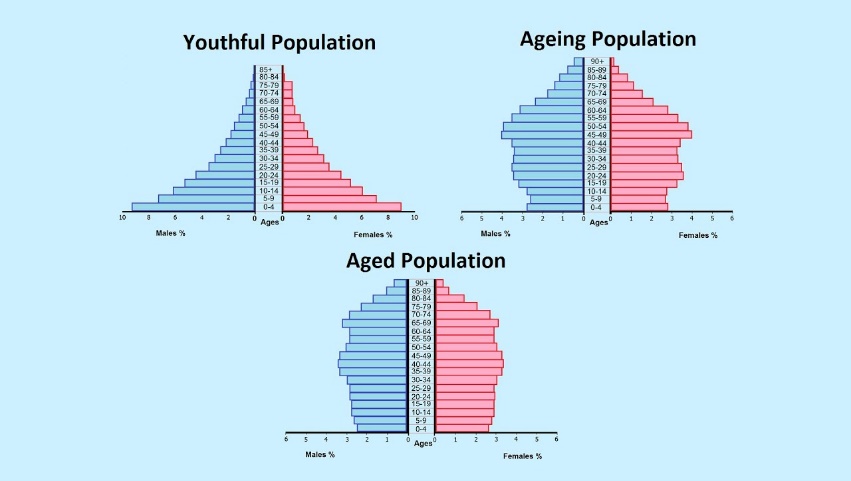
Figure 3 Different types of population structures represented by population pyramids
It is quite typical that the implementation of China's family planning policy played a crucial role in the decline of the fertility rate in the early stages because this directly eliminate the number of newborn babies. However, the implementation of the comprehensive two-child policy has had little effect in recent years, verifying that the subsequent development of the socio-economic and changes in people's concept of fertility is becoming to be the major contributor to the low fertility rate [3].
“Over the past half-century, per capita life expectancy has increased considerably, and the health of the population has improved significantly at various stages of the life cycle. Life expectancy is expected to continue to increase. Persistence of low fertility rate and longer life expectancy are expected to be the main characteristics of the situation of China's future demographic.” [3].
The ultra-low birth rate is accompanied by the steady growth of life expectancy and the slow rise of the death rate in China. What’s more, China's level of international migration has been low. The net migration rate was about -0.3 to -0.4 per 1,000 people between 2000 and 2010. The negative sign is showing that the emigration of migrants from China overweighs the immigration of migrants from foreign countries. This means that China is losing its population through emigration. What makes it worse is that usually, the migrants are young or middle-aged people, which are the main labour force of a country. This further worsened the ageing of the population in China [3].
3. The impact of aging on economy in China
3.1. Possible Impacts on the Chinese Economy
Undoubtedly, there will be significant effects on China's economy due to an ageing population.
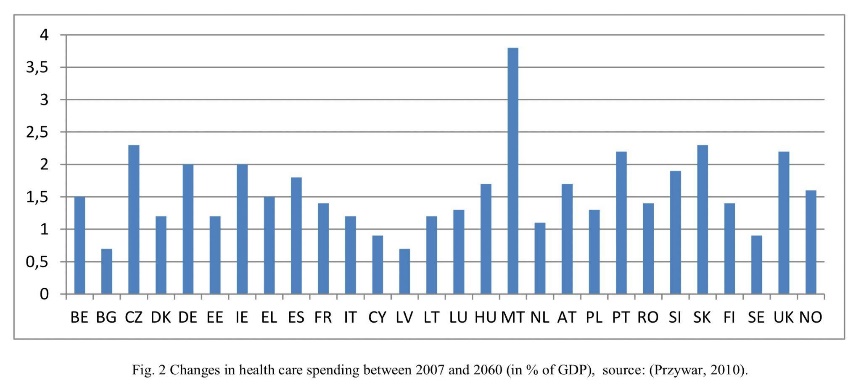
Figure 4 Changes in health care spending between 2007 and 2060 (in % of GDP) [8]
|
|
Figure 5 Forecast for dependency ratios in different countries, source: Dept for Work and Pensions | Figure 6 The changes in UK spending on pensions, source: UKPublicspending.co.uk |
It is likely that government spending on health care will be increased. Older people are more susceptible to non-communicable diseases (NCDs) due to weaker immune systems. Significant NCDs include cancer, diabetes, cardiovascular disease, and chronic respiratory disease. Nearly 60% of deaths and roughly half of the loss of effective and actual life expectancy are due to NCDs [8]. In Europe, extra spending on medical care occupies a large proportion of government budgets. As shown in Fig. 4, further growth in healthcare spending measured in percentage of GDP is expected, with the highest of around 3.75%. In Fig. 5, it can be clearly seen that the dependency ratios in all countries are nearly doubled and as a result, using the United Kingdom as an example, its pension spending measured in the % of GDP has increased significantly [8].
The increase of government expenditure may lead to a budget deficit, and the government may have to borrow money from its people or international organizations, increasing government debt.
On the other hand, the government may have to raise tax rates to cover the exceeding government spending. This can increase the burden on both government finances and taxpayers. It can induce an economic recession in severe conditions if the percentage of the economically active population out of the total population is too low.
Population ageing could cause a series of problems in China. The problems are a reduction in labour supply, decreasing household savings, weakening consumption and a decline in aggregate demand, and increasing social security spending, relatively [2]. In fact, some are very similar to the problems occurred in the Europe.
First, the ageing population is causing a shortage of workers. As people age (especially when they reach 50 and above), the likelihood of their participation in economic activities as part of the labour force tends to decrease [8].
Over the next three decades, China’s working-age population may be reduced by 170-260 million, causing a drop in labour supply. It is noteworthy that the Chinese economy has been experiencing and taking advantage of what is called a “demographic dividend” [2].
The demographic dividend belongs to the population age structure with a high proportion of the working-age population and a low total dependency ratio. It opens a window for an economy to accelerate economic growth. With the progress of the demographic transition, the growth rate of labour supply has declined, and the old-age dependency ratio has risen rapidly, the demographic dividend will be dissipated [9].
The reduction of labour supply could take away this advantage from the Chinese economy, leading to a significant increase in labour costs and hence the producers have to raise their prices. This can have negative impacts on the exports of China. For example, due to rising labour costs in China, many importers of “made in China” products are switching to import from Vietnam instead of China because it is relatively cheaper [10].
However, technological development may be able to address this issue. For instance, if China can effectively benefit from the Fourth Industrial Revolution, AI (artificial intelligence) could replace around 200-230 million workers. Nevertheless, the feasibility of substitution using AI highly depends on the job itself. For example, jobs requiring a high level of creativity and individual attention may be more challenging to replace [3].
Weakening consumption can be another undeniable consequence of population ageing. This is because older people are usually retired and earn no income [2]. Most of them rely on savings, pensions, and transfer payments from their children to cover their daily expenses. The results of the questionnaire have shown that 66.96% of the elderly people have their retired pension as one of their main sources of finance and 61.74% of them having the transfer payments from their children as one of their main sources of finance. This means they tend to have weaker purchasing power and desire compared to younger and economically active people. This can be threatening to the Chinese economy because an economy needs strong aggregate demand to grow, as household consumption is one component of GDP, a major measurement of a country's economic development.
Moreover, growing expenditure on the social security system is another significant problem of population ageing [2]. The pension system's funding gap already accounts for nearly 2% of GDP. Over the next few decades, this growing funding gap could easily increase to above 10% of GDP if no significant reform takes place. The “tax burden” may be forced to increase over time as the population ages rapidly in China, due to rising pension funds. This could place a burden on the workforce, as they are the ones who pay most of the taxes. The government may also need to cut its expenses on other policies, leading to opportunity costs.
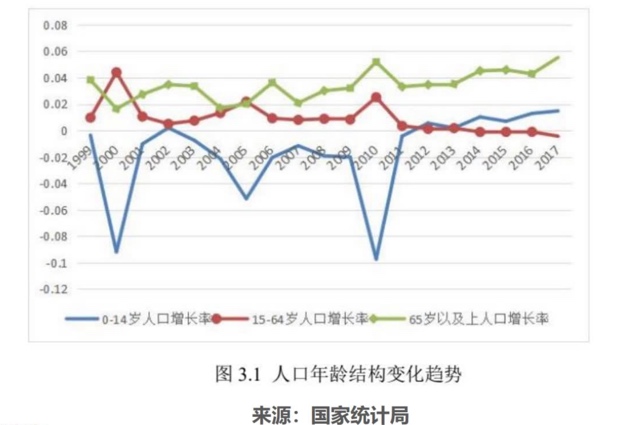
Figure 7 The changing trend of the population age structure in China, source: National Bureau of Statistics. (Note: blue line represents the growth rate of the 8-14 years old population, red line represents the growth rate of the 15-64 years old population, green line represents the growth rate of the population of 65 years old and above)
Not only is the dependency ratio in China rising rapidly, but the proportion of the oldest population is also snowballing. As mentioned earlier, China is grappling with the issue of "getting old before becoming rich," which is very different from other countries experiencing an ageing population [2].
China is still considered a developing country. Yet, it is already facing the issue of a falling birth rate and ageing population. This puts pressure on the government, as there are still many other expenses for development while expenses on the social security system have already increased.
However, every situation has two sides, and threats are often accompanied by opportunities. There is potential for medical care investments. If medical science can maintain the physical abilities of older people, their mobility can be significantly increased, allowing them to continue working. In addition to that, older individuals tend to be more experienced, and they may be more competent for a job than younger ones if they remain physically active. Furthermore, young retirees may take care of their grandchildren while the parents are working. This provides a social benefit, and since parents can work because the elderly takes on the responsibility of childcare, economic benefits also exist. What's more, older communities tend to commit fewer crimes. That is, older people are more likely to be law-abiding. According to the Australian Institute of Criminology, it is estimated that there will be a roughly 16% decline in homicide rates by 2050, with less crime overall expected. As a result, government spending on public security, such as the budget for police, may be reduced. Consequently, the budget can be used for other socially beneficial matters, for example, health care that is crucial for older people or the construction of infrastructure [8].
3.2. Possible Solutions
Firstly, urbanisation could serve as an effective approach to mitigate the issue of weakening consumption [2], as consumption per capita in urban areas is approximately 2-3 times higher than in rural areas. At present, the urbanisation rate in China stands at 56%. If this rate could be increased to 80% by 2049, the rise in consumption resulting from urbanisation could offset the decrease in consumption caused by an ageing population. Indeed, the potential for continuous income growth may further boost Chinese household consumption, shaping the future global narrative of the Chinese economy [2].
As government policies have a significant impact on China's population ageing process, further improvements and relaxation of birth control policies are necessary for China's sustainable and balanced long-term development. Future generations will be better equipped to address the challenges of an ageing population, thanks to such policy changes which have bought them time. However, it should be noted that any alterations to these policies are unlikely to reverse the population ageing trend [3].
Promoting immigration may also be an option. In fact, numerous countries, and regions, such as Singapore, Hong Kong (China), and France, have employed this strategy to improve their population structure and mitigate the effects of an ageing population on the economy. As migrants are typical of working age or highly skilled, this approach can enhance the country's productivity, labour force quantity, and human capital. Consequently, it can counteract the negative effects of an ageing population, such as labour shortages and high dependency rates.
Nonetheless, it may be challenging and unrealistic for China to counterbalance the impact of a declining birth rate by increasing immigration in the short term [3]. Currently, China's net migration is negative, and it will take time for immigration to rise and achieve a positive net migration rate. Despite this, promoting immigration remains a viable strategy for pursuing long-term sustainable growth.
In recent years, there has been growing concern about the plight of elderly individuals living alone. This includes cases of "lonely death," accidental injuries, and mental crises. Many older people living in isolation face significant challenges. Ensuring that elderly individuals living alone can spend their final years in a stable and dignified manner has become a pressing issue in China's ageing process [11].
“Notably, surveys conducted by the National Office on Ageing reveal that over 90% of elderly people in China prefer to remain in their homes rather than move to care facilities for older individuals [12]. Data from the National Bureau of Statistics of China indicates that the number of households with a single person aged 65 or older living alone increased from 7,835,140 in 2000 to 18,243,921 in 2010, representing a growth of more than 100% within a decade [13]. All the above data and statistics are reliable and verifiable, as they originate from official government sources and documents.”
I also did a primary research with family member of the elderly people on the basic information and needs of the elderly people who live in China. 118 effective answers to the questionnaire are received and they are all live in eastern parts of China. My own questionnaire supports these findings: only 2.54% of the 118 elderly respondents I surveyed lived in nursing homes or retirement facilities.
Consequently, it is crucial that communities offer increased support to the elderly, as most of them choose to spend the final stages of their lives in their communities. The questionnaire I distributed revealed that 72.88% of family members of elderly individuals not living in care facilities believe that their communities should improve various aspects, including infrastructure, regular home visit services, healthcare, and nursing. Of the 118 elderly respondents, 38.26% have a chronic disease, with a quarter of them feeling that these conditions greatly impact their quality of life. Moreover, 22.61% are in a sub-health state. This highlights the need for communities to monitor the health conditions of elderly individuals, ensuring their chronic diseases do not worsen or require urgent attention. According to the questionnaire results, 58.57% have hypertension, 34.29% suffer from rheumatoid arthritis, 31.43% have diabetes, and 30% have cardiovascular disease (note: percentages do not total 100% as respondents could select multiple options, given that many older individuals have more than one health issue). Many of these conditions necessitate close health monitoring for safety reasons. However, 55.94% of respondents live alone or with their partner, suggesting that the responsibility for health monitoring may fall on the communities in which they reside, as elderly individuals may not be able to adequately care for themselves.
4. Conclusions
China's population ageing has grown increasingly severe in recent years, leading to various issues such as a reduced workforce, increased government spending on healthcare and social security systems, and a shrinking labour supply [2]. Beyond economic concerns, the well-being of elderly individuals is also under threat. Notably, China faces the unique challenge of "getting old before getting rich", which other countries experiencing population ageing do not encounter [2]. However, there are some positive aspects, such as new business opportunities and a safer society, as elderly people are less likely to commit crimes [8]. Despite these benefits, the overall impact of an ageing population appears to be more threatening. This is why countries worldwide are striving to slow down the ageing process and overcome this challenge.
The rate of population ageing and the increase in the dependency ratio in China are alarmingly rapid. The percentage of elderly people in the total population rose by 5.38% during the 10 years between 2010 and 2020, while the percentage of those aged 65 and above increased by 4.58%. The consequences are becoming evident. The decline in labour supply has affected China's product exports as labour costs rise. Weakening consumption is also a concern, as it can result in a downturn in the Chinese economy. The growing social security expenditure may lead to a government budget deficit and have long-lasting impacts [2].
Given the multiple side effects of this issue, it is crucial to develop suitable solutions and adopt multifaceted approaches to address the ageing population problem. Several potential economic strategies were discussed earlier, such as promoting urbanisation, further relaxing fertility policies, and encouraging immigration. To improve the living quality of elderly people, it is recommended that community support for these individuals be enhanced.
The implementation of comprehensive and effective strategies should be prioritised as soon as possible, given the urgency of the population ageing issue and its potential to significantly impact the economy. It is crucial to focus on mitigating the negative effects of an ageing population while capitalising on potential opportunities in areas such as medical care investments and community support. If prompt action is taken, this issue may present a new opportunity for the Chinese economy rather than pose a significant threat.
References
[1]. National Bureau of Statistics of China. Stats.gov.cn. (2022e). http://www.stats.gov.cn/english/
[2]. Huang, Y. (2020, January 5). Special issue: challenges of population ageing in China. Home Page. https://doi.org/10.1080/17538963.2019.1710058
[3]. Peng, X. (2020, November 4). Coping with population ageing in mainland China. Home Page. https://doi.org/10.1080/17441730.2020.1834197
[4]. Yin, X. (2015). Population Aging Prediction in China Based on Trend Extrapolation Model. Aging Research, 02(03), 15–21. https://doi.org/10.12677/ar.2015.23003
[5]. Shrestha, L. B. (2000). Population aging in developing countries. Health Affairs, 19(3), 204–212. https://doi.org/10.1377/hlthaff.19.3.204
[6]. Yuan, J., Wu, Z., & Wu, D. (2007). CHINESE JOURNAL OF POPULATION SCIENCE, 41–47. https://www.ncbi.nlm.nih.gov/pmc/articles/PMC5902982/
[7]. Han, X., Li, J., & Wang, N. (2018). Spatiotemporal evolution of Chinese ageing from 1992 to 2015 based on an improved Bayesian space-time model. BMC Public Health, 18(1). https://doi.org/10.1186/s12889-018-5417-6
[8]. Marešová, P., Mohelská, H., & Kuča, K. (2015). Economics Aspects of Ageing Population. Doi.org. https://doi.org/10.1016/S2212-5671(15)00492-X
[9]. Bulletin of the Seventh National Population Census (No. 5). Stats.gov.cn. (2022a). http://www.stats.gov.cn/xxgk/sjfb/zxfb2020/202105/t20210511_1817200.html
[10]. Vanham, P. (2018, September 11). The story behind Viet Nam’s miracle growth. World Economic Forum. https://www.weforum.org/agenda/2018/09/how-vietnam-became-an-economic-miracle/
[11]. Zhao, W. (2021, December 29). Survey on the status quo of widows and elderly people living alone: different degrees of difficulty in seeking medical treatment with no one to accompany them and no one to comfort them. http://www.news.cn/local/2021-10/14/c_1127954874.htm
[12]. Li, X. (2010, October 20). “Empty Nest” is not “Empty Heart”, How Can Over 100 Million Empty Nesters Enjoy Their Old Life? Ministry of Civil Affairs of the People’s Republic of China. https://www.mca.gov.cn/n152/n166/c45331/content.html
[13]. Feng, N. (2012). Tabulation of the 2010 Population Census of the People’s Republic of China. http://www.stats.gov.cn/sj/pcsj/rkpc/6rp/indexch.htm
Cite this article
Xiao,Y. (2023). Demographic Transitions and Economic Consequences: An Analysis of Population Ageing in China. Advances in Economics, Management and Political Sciences,2,59-69.
Data availability
The datasets used and/or analyzed during the current study will be available from the authors upon reasonable request.
Disclaimer/Publisher's Note
The statements, opinions and data contained in all publications are solely those of the individual author(s) and contributor(s) and not of EWA Publishing and/or the editor(s). EWA Publishing and/or the editor(s) disclaim responsibility for any injury to people or property resulting from any ideas, methods, instructions or products referred to in the content.
About volume
Volume title:
© 2024 by the author(s). Licensee EWA Publishing, Oxford, UK. This article is an open access article distributed under the terms and
conditions of the Creative Commons Attribution (CC BY) license. Authors who
publish this series agree to the following terms:
1. Authors retain copyright and grant the series right of first publication with the work simultaneously licensed under a Creative Commons
Attribution License that allows others to share the work with an acknowledgment of the work's authorship and initial publication in this
series.
2. Authors are able to enter into separate, additional contractual arrangements for the non-exclusive distribution of the series's published
version of the work (e.g., post it to an institutional repository or publish it in a book), with an acknowledgment of its initial
publication in this series.
3. Authors are permitted and encouraged to post their work online (e.g., in institutional repositories or on their website) prior to and
during the submission process, as it can lead to productive exchanges, as well as earlier and greater citation of published work (See
Open access policy for details).
References
[1]. National Bureau of Statistics of China. Stats.gov.cn. (2022e). http://www.stats.gov.cn/english/
[2]. Huang, Y. (2020, January 5). Special issue: challenges of population ageing in China. Home Page. https://doi.org/10.1080/17538963.2019.1710058
[3]. Peng, X. (2020, November 4). Coping with population ageing in mainland China. Home Page. https://doi.org/10.1080/17441730.2020.1834197
[4]. Yin, X. (2015). Population Aging Prediction in China Based on Trend Extrapolation Model. Aging Research, 02(03), 15–21. https://doi.org/10.12677/ar.2015.23003
[5]. Shrestha, L. B. (2000). Population aging in developing countries. Health Affairs, 19(3), 204–212. https://doi.org/10.1377/hlthaff.19.3.204
[6]. Yuan, J., Wu, Z., & Wu, D. (2007). CHINESE JOURNAL OF POPULATION SCIENCE, 41–47. https://www.ncbi.nlm.nih.gov/pmc/articles/PMC5902982/
[7]. Han, X., Li, J., & Wang, N. (2018). Spatiotemporal evolution of Chinese ageing from 1992 to 2015 based on an improved Bayesian space-time model. BMC Public Health, 18(1). https://doi.org/10.1186/s12889-018-5417-6
[8]. Marešová, P., Mohelská, H., & Kuča, K. (2015). Economics Aspects of Ageing Population. Doi.org. https://doi.org/10.1016/S2212-5671(15)00492-X
[9]. Bulletin of the Seventh National Population Census (No. 5). Stats.gov.cn. (2022a). http://www.stats.gov.cn/xxgk/sjfb/zxfb2020/202105/t20210511_1817200.html
[10]. Vanham, P. (2018, September 11). The story behind Viet Nam’s miracle growth. World Economic Forum. https://www.weforum.org/agenda/2018/09/how-vietnam-became-an-economic-miracle/
[11]. Zhao, W. (2021, December 29). Survey on the status quo of widows and elderly people living alone: different degrees of difficulty in seeking medical treatment with no one to accompany them and no one to comfort them. http://www.news.cn/local/2021-10/14/c_1127954874.htm
[12]. Li, X. (2010, October 20). “Empty Nest” is not “Empty Heart”, How Can Over 100 Million Empty Nesters Enjoy Their Old Life? Ministry of Civil Affairs of the People’s Republic of China. https://www.mca.gov.cn/n152/n166/c45331/content.html
[13]. Feng, N. (2012). Tabulation of the 2010 Population Census of the People’s Republic of China. http://www.stats.gov.cn/sj/pcsj/rkpc/6rp/indexch.htm










